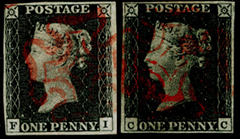 First Issues Collectors Club
of stamps and philatelic material
First Issues Collectors Club
of stamps and philatelic material
Home - Catalog - Categories - Index - Journal - Exhibits - Auctions - Forgeries - Join
 First Issues Collectors Club
of stamps and philatelic material
First Issues Collectors Club
of stamps and philatelic material
Home - Catalog - Categories - Index - Journal - Exhibits - Auctions - Forgeries - Join
| first issues > countries > uruguay, carrier issue |
Imperforate, no watermark, lithographed.
Printed by Mége and Aubriot (Willems?), in Montevideo.
| Description | Scott | SG | Mi | Y&T† | ||
|---|---|---|---|---|---|---|
| October 1856 | ||||||
| 60 centavos blue | 1 | 1 | 1 | |||
| 80 centavos green | 2 | 2 | 2 | |||
| 1 real red | 3 | 3 | 3 | |||
| October 1, 1857. Modified design. | ||||||
| 60 centavos blue | 3B | 4 | 1A | |||
† Yves & Tellier distinguishes shades in YT1-3.
The first stamps issued in Uruguay were ordered by the Administrator General of Posts, Atanasio Lapido, who also happened to be in charge of the stage coach service. They could be considered a private issue, but must have had official status. The inscription "Diligencia" means "Stage coach", and indicate the means of transporting of the mail. They were only valid for mail within Uruguay. The first stamps issued by the Uruguayan government was the issue of 1859.
These stamps were printed in sheets of 35, seven rows of five stamps each. The design is 18½ mm wide by 22 mm. high. For the 60 centavos one die was transferred to the printing stone 35 times, and there are therefore no varieties. The 80 centavos was produced by removing the value inscription from the 60 centavos stone, substituting the value by hand. There are therefore 35 varieties of the 80 centavos. A similar process was used for the one real, but this time the whole bottom label was replaced. Again 35 varieties can be found, not by the value engraving, but by the slightly different placement of the whole value label. Plating these two high values is therefore possible - if you have enough money.
The stamps are placed very close on the printing stone, and therefore it is very rare to find these with four margins clear of the design.
There is some confusion about the actual date of issue. Most sources have October 1, 1856. However, a circular from the Administration of Posts and Mail Coaches dated October 14, 1856 is the earliest known documentation of the mail service. However, this document refers to use of stamps in places other than Montevideo: "... in the same manner as is now done at the General Headquarters". This could be taken to mean that stamps had already been used in the capital, perhaps since October 1.
Genuinely used copies are pen cancelled or not cancelled at all. No handstamps or other cancellors were ever used. These stamps were never used for fiscal purposes either. The Scott catalog does not value used examples, perhaps in recognition of the fact that it can be difficult to distinguish between a mint and a used copy.
The first and second issue can be distinguished by the border around the central design, and by the number of rays in the sun. There are 105 rays in the first issue, only 67 in the second.
Two additional values of the second issue were in circulation, perhaps only for a few days, between August and November 1857. A 180 centavos green and a 240 centavos red, paying the rate on foreign mail. However, it was soon noted that the inscription "Diligencia" did not apply to these stamps, since the mail would have to be transported by water to reach Buenos Aires in Argentina, for example. These stamps were replaced by Scott #4 - 6 in March 1858.
Forgers have had a field day with these stamps. The design is somewhat crude, and the stamps are rare, giving plenty of opportunity for the forger to deceive a collector. It is well advised to get a certificate for these stamps, but you can try your hand at forgery detection by visiting Bill Claghorn's excellent Comparative Forgery Identification Site.
For more on stamps from Uruguay please see Uruguay, government issue.
Image from David Olson.
| FI ref: 64 | Page credit: JA |
| Page created 19 Feb 2014 | Page updated 25 Jan 2016 |